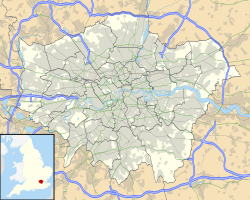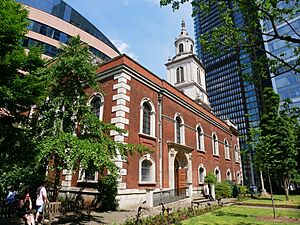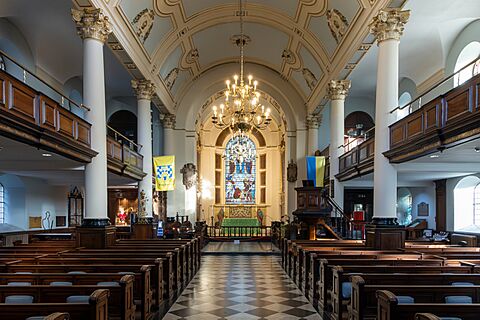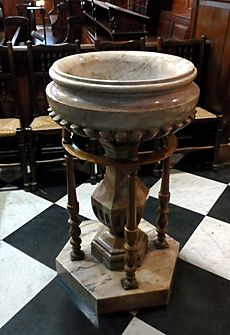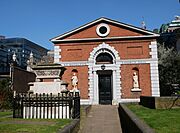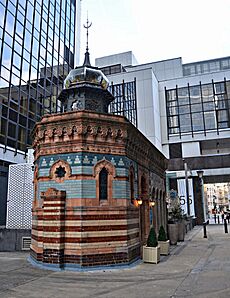St Botolph-without-Bishopsgate facts for kids
Quick facts for kids St Botolph-without-Bishopsgate |
|
|---|---|

Exterior from Bishopsgate
|
|
| 51°31′0.15″N 0°4′53.96″W / 51.5167083°N 0.0816556°W | |
| Country | England |
| Denomination | Church of England and Antiochian Orthodox Church |
| Previous denomination | Roman Catholicism |
| Architecture | |
| Heritage designation | Grade II* |
| Administration | |
| Diocese | London |
St Botolph-without-Bishopsgate is a historic Church of England church. It is located in the City of London, just outside where the old city walls used to be. This area is known as Bishopsgate Without. The church is also considered part of London's East End.
Next to the church, there is a large churchyard and a former school building. The church has special connections with two old London groups: the Worshipful Company of Coopers (barrel makers) and the Worshipful Company of Bowyers (bow makers).
Contents
Where is St Botolph's Church?
The church stands on the west side of a road called Bishopsgate. This road was once a Roman road named Ermine Street. It is also very close to Liverpool Street station.
Both the church and the street get their names from the 'Bishop's Gate'. This was a gate in London's old defensive wall. The gate stood about 30 meters south of the church.
In 1598, a writer named Stow described the church. He said it was in a nice churchyard, right next to the city's defensive ditch. This ditch made it harder for enemies to attack the city walls.
Why is it called St Botolph?
This church is one of four medieval London churches named after Saint Botolph. He was a saint from the 7th century in East Anglia. Each of these churches was built near one of London's main gates.
The other three churches were:
- St Botolph's Aldgate, very close by.
- St Botolph's Aldersgate near the Barbican Centre.
- St Botolph's, Billingsgate by the river. This last church was destroyed in the Great Fire of London and was never rebuilt.
By the late 1000s, Saint Botolph was seen as the patron saint of boundaries. This also meant he was a saint for trade and travel. People honored Botolph a lot before the story of St Christopher became popular among travelers.
It is thought that the church outside Aldgate was the first in London named after Botolph. The other churches likely got their names soon after.
A Look at the Church's History
The first official mention of the church in writing was in 1212. However, some people believe that Christians might have worshipped on this spot even earlier, possibly since Roman times.
The church was lucky and survived the Great Fire of London in 1666. However, it was later rebuilt between 1724 and 1729.
Medieval Times
Around 1307, the Knights Templar (a famous medieval group) were questioned here. They faced charges of corruption. In 1413, records show a female hermit lived here. She received money each year from the Sheriff to support herself.
The church almost burned down in the Great Fire of London. Part of the sexton's (church caretaker's) house was pulled down to stop the fire from spreading. By 1708, the old Gothic church had been changed. It had new columns inside to support the roof and galleries.
The Church Today
| St. Botolphs Bishopsgate Church Rebuilding Act 1723 | |
|---|---|
| Act of Parliament | |
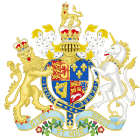
|
|
| Long title | An Act for re-building the Parish Church of St. Botolph's, Bishopsgate, in the City of London, at the Charge of the Inhabitants of the said Parish. |
| Citation | 10 Geo. 1. c. 5 Pr. |
| Territorial extent | Great Britain |
| Dates | |
| Royal assent | 19 March 1724 |
| Commencement | 9 January 1724 |
| Other legislation | |
| Relates to | St. Martin-in-the Fields Church Rebuilding Act 1723 |
|
Status: Current legislation
|
|
In 1710, the people of the parish asked Parliament to rebuild the church. Nothing happened then. But in 1723, the church was found to be too old to fix. So, the parishioners asked again.
They got a special law passed, called the St. Botolphs Bishopsgate Church Rebuilding Act 1723. They set up a temporary building in the churchyard. Then they started to rebuild the church. The first stone was laid in 1725. The new building was ready for services in 1728, but it was fully finished in 1729. James Gold or Gould was the designer. During construction, they even found the foundations of the original Anglo-Saxon church!
To make the church look impressive from Bishopsgate, the architect put the tower at the east end. The ground floor of the tower, with a special triangular shape on the outside, became the chancel (the part of the church where the altar is). The east end and tower are made of stone. The rest of the church is brick with stone decorations.
Inside, the church has a main area (nave) and side sections (aisles). These are separated by columns. The nave has a rounded ceiling, like the inside of a barrel. The church was found to be too dark, so a large window was added. However, an organ was put in front of it in 1764, blocking some light. In 1820, a lantern (a small tower with windows) was added to the roof.
The church was named a Grade II* listed building on January 4, 1950. This means it is a very important historic building. It also has memorials for soldiers who died in wars.
The church had minor damage from bombs during the Second World War. It was also damaged in the 1993 Bishopsgate bombing.
Famous People Connected to the Church
Many famous people have connections to St Botolph's:
- The baby son of the famous playwright Ben Jonson is buried in the churchyard.
- Edward Alleyn, a well-known actor, was baptized here in 1566.
- Emilia Lanier (born Bassano) was baptized on January 27, 1569. She is thought to be the first Englishwoman to become a professional poet. She also married Alfonso Lanier in this church on October 18, 1592.
- Mary Wollstonecraft, who wrote A Vindication of the Rights of Woman, was baptized here in 1759.
At one time, the writer Stephen Gosson was the rector (the main priest) of the church.
Church Hall and Surroundings
Inside the churchyard, you can find the church hall. This building is also a Grade II listed building. It used to be the hall for the Worshipful Company of Fan Makers. It is a single-story building made of red brick and stone. It has special spots (niches) with figures of charity children.
These figures used to be painted by schoolchildren every year. Now, they have been cleaned and moved inside the hall to protect them from theft. Modern copies stand in the niches on the front of the building.
Also in the churchyard is the entrance to an old underground Victorian Turkish bath. It was designed by Harold Elphick. It opened on February 5, 1895. Henry and James Forder Neville, who owned other Turkish baths, opened it.
Images for kids


